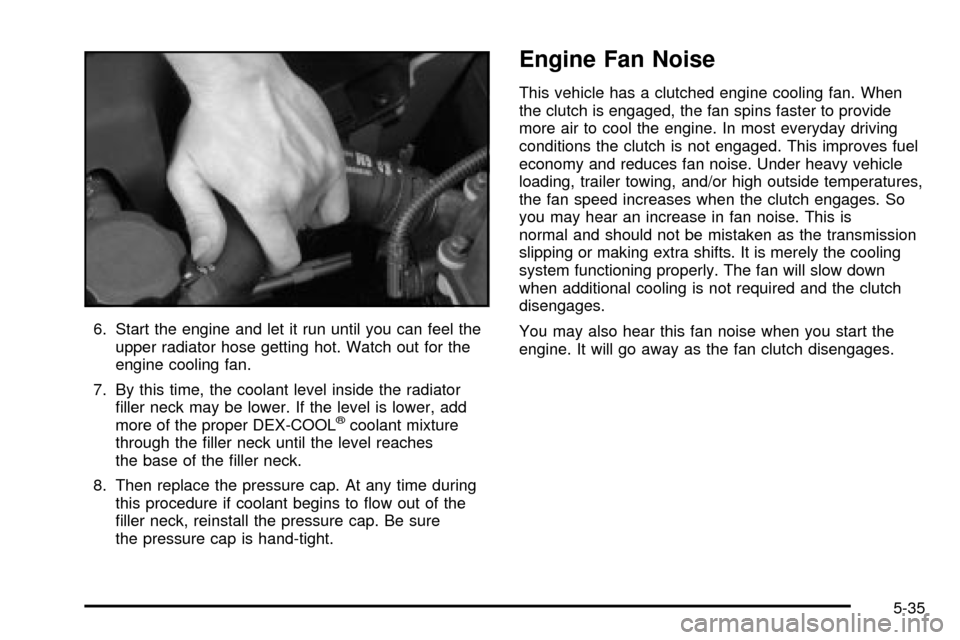Page 320 of 436
3. Fill the radiator with the proper DEX-COOLž
coolant mixture, up to the base of the ®ller
neck. SeeEngine Coolant on page 5-24for more
information about the proper coolant mixture.4. Then ®ll the coolant recovery tank to the FULL
COLD mark.
5. Put the cap back on the coolant recovery tank, but
leave the radiator pressure cap off.
5-34
Page 321 of 436

6. Start the engine and let it run until you can feel the
upper radiator hose getting hot. Watch out for the
engine cooling fan.
7. By this time, the coolant level inside the radiator
®ller neck may be lower. If the level is lower, add
more of the proper DEX-COOL
žcoolant mixture
through the ®ller neck until the level reaches
the base of the ®ller neck.
8. Then replace the pressure cap. At any time during
this procedure if coolant begins to ¯ow out of the
®ller neck, reinstall the pressure cap. Be sure
the pressure cap is hand-tight.
Engine Fan Noise
This vehicle has a clutched engine cooling fan. When
the clutch is engaged, the fan spins faster to provide
more air to cool the engine. In most everyday driving
conditions the clutch is not engaged. This improves fuel
economy and reduces fan noise. Under heavy vehicle
loading, trailer towing, and/or high outside temperatures,
the fan speed increases when the clutch engages. So
you may hear an increase in fan noise. This is
normal and should not be mistaken as the transmission
slipping or making extra shifts. It is merely the cooling
system functioning properly. The fan will slow down
when additional cooling is not required and the clutch
disengages.
You may also hear this fan noise when you start the
engine. It will go away as the fan clutch disengages.
5-35
Page 398 of 436

97,500 Miles (162 500 km)
qCheck rear/front axle ¯uid level and add ¯uid as
needed. Check constant velocity joints and axle
seals for leaking.
qRotate tires. See
Tire Inspection and Rotation on
page 5-55for proper rotation pattern and additional
information.(See footnote +.)
100,000 Miles (166 000 km)
qV8 Engine Only: Inspect spark plug wires.An Emission Control Service.
qReplace spark plugs.An Emission Control Service.
qChange automatic transmission ¯uid and ®lter if
the vehicle is mainly driven under one or more
of these conditions:
þ In heavy city traffic where the outside
temperature regularly reaches 90ÉF (32ÉC) or
higher.
þ In hilly or mountainous terrain.
þ When doing frequent trailer towing.
þ Uses such as found in taxi, police or delivery
service.qIf you haven't used your vehicle under severe service
conditions listed previously and, therefore, haven't
changed your automatic transmission ¯uid, change
both the ¯uid and ®lter
qAutomatic Transfer Case Only: Change transfer
case ¯uid.
qV8 Engine Only: Inspect Positive Crankcase
Ventilation (PCV) valve.
An Emission Control Service.
150,000 Miles (240 000 km)
qDrain, ¯ush and re®ll cooling system (or every
60 months since last service, whichever occurs ®rst).
See
Engine Coolant on page 5-24for what to use.
Inspect hoses. Clean radiator, condenser, pressure
cap and neck. Pressure test the cooling system
and pressure cap.
An Emission Control Service.
qInspect engine accessory drive belt.An Emission
Control Service.
6-10
Page 404 of 436

Part C: Periodic
MaintenanceInspections
Listed in this part are inspections and services which
should be performed at least twice a year (for instance,
each spring and fall).
You should let your dealer's
service department do these jobs. Make sure any
necessary repairs are completed at once.
Proper procedures to perform these services may be
found in a service manual. SeeService Publications
Ordering Information on page 7-9.
Steering, Suspension and Front
Drive Axle Boot and Seal Inspection
Inspect the front and rear suspension and steering
system for damaged, loose or missing parts, signs of
wear or lack of lubrication. Inspect the power steering
lines and hoses for proper hook-up, binding, leaks,
cracks, cha®ng, etc. Clean and then inspect the drive
axle boot seals for damage, tears or leakage. Replace
seals if necessary.
Exhaust System Inspection
Inspect the complete exhaust system. Inspect the body
near the exhaust system. Look for broken, damaged,
missing or out-of-position parts as well as open seams,
holes, loose connections or other conditions which
could cause a heat build-up in the ¯oor pan or could let
exhaust fumes into the vehicle. See
Engine Exhaust
on page 2-32.
Fuel System Inspection
Inspect the complete fuel system for damage or leaks.
Engine Cooling System Inspection
Inspect the hoses and have them replaced if they
are cracked, swollen or deteriorated. Inspect all pipes,
®ttings and clamps; replace as needed. Clean the
outside of the radiator and air conditioning condenser.
To help ensure proper operation, a pressure test of
the cooling system and pressure cap is recommended
at least once a year.
6-16
Page 431 of 436

Part D - Recommended Fluids and
Lubricants..................................................6-18
Part E - Maintenance Record...........................6-20
PASSENGER DOOR AJAR..............................3-63
Passing.................................................4-13, 4-57
Passlock
ž......................................................2-18
Personalization, Climate Controls......................3-34
Personalization...............................................3-54
Plan Ahead When Possible................................ 7-7
Playing a Cassette Tape..................................3-78
Playing a Compact Disc..................3-70, 3-80, 3-87
Playing a Speci®c Loaded Compact Disc............3-89
Playing the Radio...........................3-65, 3-72, 3-82
Power Steering...............................................4-10
Power...........................................................3-20
Accessory Outlets........................................3-20
Door Locks.................................................. 2-9
Electrical System.........................................5-88
Lumbar Controls........................................... 1-3
Reduced Engine Light..................................3-48
Seat............................................................ 1-2
Steering Fluid.............................................5-36
Windows....................................................2-15
Programmable Automatic Door Locks.................2-10
Programmable Locking Feature.........................2-10
Programmable Unlocking Feature......................2-11
Programming the HomeLink Transmitter.............2-40
Q
Questions and Answers About Safety Belts.........1-13
R
Radiator Pressure Cap....................................5-26
Radio Messages.....................................3-70, 3-77
Radios..........................................................3-64
Care of Your Cassette Tape Player...............3-107
Care of Your CD and DVD Player................3-108
Care of Your CDs and DVDs.......................3-108
Radio Personalization.................................3-105
Radio with Cassette and CD.........................3-72
Radio with CD............................................3-65
Radio with Six-Disc CD................................3-82
Rear Seat Audio........................................3-104
Setting the Time..........................................3-64
Theft-Deterrent..........................................3-105
Understanding Reception............................3-106
RainsenseŸ Wipers........................................3-10
RDS Messages..............................3-69, 3-76, 3-86
Reading Lamps..............................................3-19
REAR ACCESS OPEN....................................3-62
Rear Axle......................................................5-47
Locking......................................................4-10
Rear Climate Control System............................3-30
11